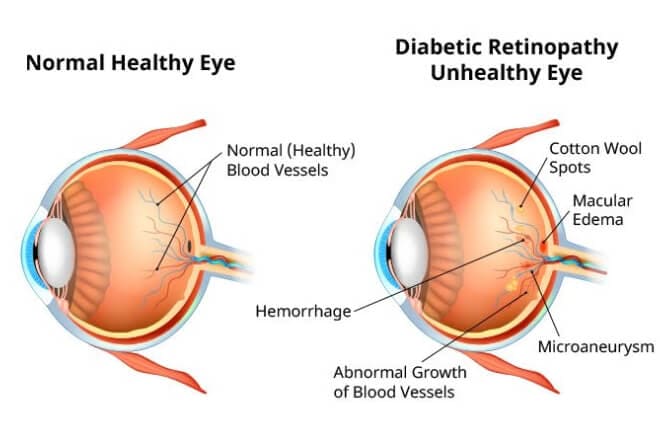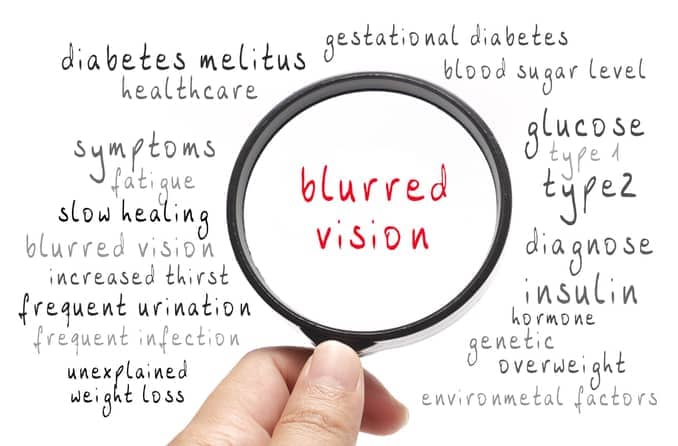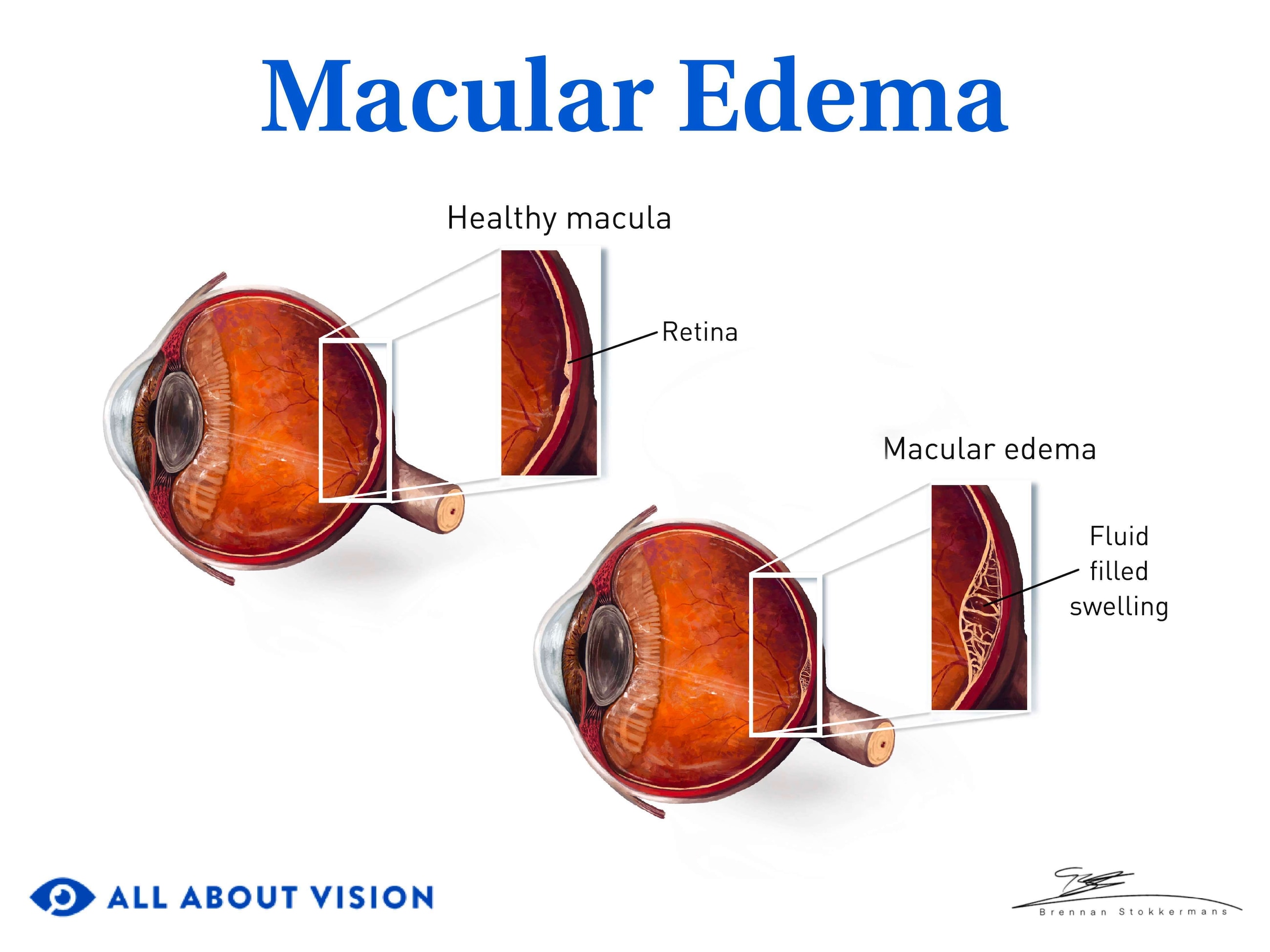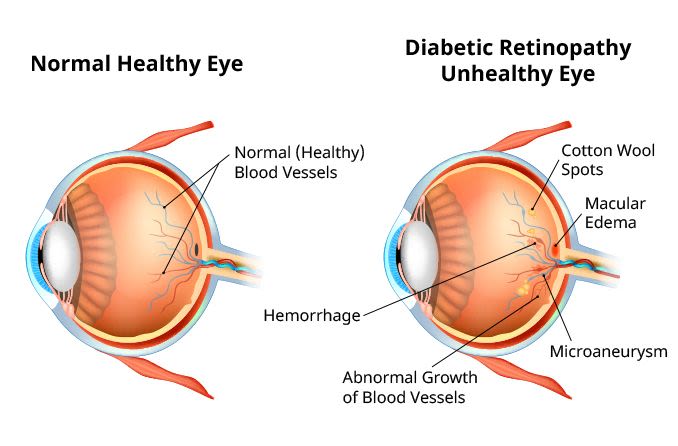Blurred vision and diabetes
Blurry vision is a common symptom of diabetes, but many other things can cause it too. If you've already been diagnosed with diabetes, blurred vision could mean your blood sugar isn't being controlled well enough. It may also mean there's a problem in your eyes or another part of your body.
Different forms of diabetes can cause blurry vision. The most common types are:
Type 1 diabetes – Your immune system mistakenly stops your pancreas from making insulin.
Type 2 diabetes – There is a problem with the way your body makes or uses insulin. More than 9 in 10 people with diabetes have this type.
Gestational diabetes – This is high blood sugar in a non-diabetic woman during pregnancy.
Low and high blood sugar
Your blood sugar level measures how much glucose (a sugar that gives you energy) is in your blood.
Normal blood sugar is between 70 and 100 mg/dL after fasting for at least eight hours.
High blood sugar (hyperglycemia)
You can develop serious eye problems when your blood sugar is over 100 mg/dL ( hyperglycemia ) too often. These problems can cause blurred vision, and some can lead to vision loss.
Blurry vision can also happen when your blood sugar gets too high after eating foods high on the glycemic index. You're more likely to have glucose spikes when your food is high in unhealthy carbs.
You have hyperglycemia when your blood sugar is over 180 mg/dL one to two hours after a meal. This target number may be higher or lower, depending on what your doctor says.
Some people with diabetes notice blurry vision in the morning when their blood sugar is too high. This is called the dawn phenomenon. It affects about half of everyone with type 1 or type 2 diabetes.
High glucose levels can make parts of your eyes swell up. Too much swelling makes it harder for your eyes to focus, so objects look blurred or fuzzy.
It can also make you feel:
Very thirsty
Like you have to pee a lot
Tired or weak
Blurred vision should go away as your blood sugar level gets closer to normal.
Low blood sugar (hypoglycemia)
Hypoglycemia usually means your blood sugar level is below 70 ml/dL.
Low blood sugar affects around 4 in 5 people with type 1 diabetes and half of people with type 2 diabetes at least once a month, according to the National Institute of Diabetes and Digestive and Kidney Diseases (NIDDK).
Research shows that hypoglycemia can worsen diabetic eye diseases, especially diabetic retinopathy.
Low blood sugar can cause blurry vision and other symptoms. They include:
Feeling hungry, dizzy or anxious
Feeling weak, exhausted or confused
Sweating
Shaking
These symptoms should go away when your blood sugar goes back to normal.
Diabetic retinopathy
The retina is a thin layer of cells in the back of each eye that helps you see. Diabetic retinopathy happens when the retina's tiny blood vessels are damaged.
Researchers believe around 1 in 3 diabetic people have some level of diabetic retinopathy. It's the top cause of vision loss in people with diabetes.
At first, diabetic retinopathy usually doesn't cause symptoms and is painless. Routine dilated eye exams can help you catch these problems early on and save your eyesight.
As retinopathy gets worse, it can cause symptoms like:
Blurred vision
Eye floaters (small spots or shapes in your vision)
Eye pain
Vision loss
Diabetic retinopathy happens because your blood sugar levels are too high. By controlling your glucose levels, you may be able to prevent future vision loss or even reverse some existing damage.
People with more advanced retinopathy may need treatment from a medical eye doctor (ophthalmologist).

Click on image to enlarge.
Retinopathy increases the risk for other diabetic eye problems that cause blurry eyesight and, potentially, vision loss. They include:
Diabetic macular edema
Diabetic macular edema (DME) is when diabetic retinopathy causes swelling in the small spot on your retina called the macula. This can cause:
Blurred vision
Worsening eyesight over time
Objects that look wavy or curved
Faded colors
Loss of vision in the center of your eyesight
Some people with DME have mild or no symptoms, but these can get worse over time. Managing your blood sugar and other treatments could help your DME symptoms and protect your eyesight.
Neovascular glaucoma
Blood vessel problems in your retina can raise the pressure inside your eye. If it gets too high, it can damage your optic nerve and other parts of your eye that help you see.
This is called neovascular glaucoma (NVG) . It can eventually cause:
Blurry vision
A red, painful eye
Vision loss
Diagnosing and treating NVG early can help you keep as much of your eyesight as possible.
LEARN MORE: What is glaucoma?
Retinal detachment
As it worsens, scarring from diabetic retinopathy can make your retina peel away from the back of your eye. This is an urgent problem called tractional retinal detachment. It needs to be treated right away.
It can cause:
Sudden blurry vision
The appearance of a dark curtain or shadow over part of your vision
Many new eye floaters
Flashes of light
Vision loss
READ MORE: How to lower your risk of diabetic eye disease
Other ways diabetes can cause blurred vision
Other diabetes-related complications and side effects can make your vision blurry, too. Some of them are:
Cataracts
High blood sugar raises your risk of getting cataracts.
The cloudiness of a cataract changes the way light enters your eye. This can cause symptoms like:
Blurry vision
Light sensitivity
Problems seeing in low light
Yellowed or dull colors
These problems can be treated with cataract surgery. It's a quick, safe procedure that helps millions of people every year.
Reactions to treatment
Most people use at least one kind of medication to help manage their diabetes.
The hormone insulin can be prescribed to help your body use glucose better. It can cause vision changes for a little while after you start taking it.
Blurriness can also be a sign of a serious insulin side effect, so tell your doctor if you notice it.
Diabetic drugs like metformin can cause blurry vision, too.
Many times, metformin is the first medicine prescribed to someone with type 2 diabetes. Blurred eyesight is a relatively common side effect, but you should still tell your doctor if you experience it.
Eye prescription isn't accurate
Diabetic blurry vision can come and go over time. If it's causing fuzzy vision during an eye exam, your eye prescription might not be accurate when your blood sugar is normal.
This means your eyesight won't be as sharp as it should be when you're wearing glasses or contacts.
For the best results, your blood sugar levels should be stable for at least one full week leading up to your exam.
Dry eye
A diabetic person is twice as likely to have dry eyes as someone who doesn't have diabetes. This can cause:
Blurred vision that gets better when you blink
Watery eyes
Red eyes
Scratchy, stinging or burning feelings in your eyes
Light sensitivity
Dry eye sometimes goes away as soon as your blood sugar is under control. Other people may need to use dry eye drops, punctal plugs or other treatments.
Diabetic ketoacidosis
Chemicals called ketones can build up in your body when it doesn't make enough insulin. This can lead to a life-threatening emergency called ketoacidosis . It needs to be treated right away.
Ketoacidosis is more common in people with type 1 diabetes, but it can also happen with type 2 diabetes that requires insulin. It can affect someone who hasn't been diagnosed with diabetes, too.
Some of the warning signs are:
Feeling really thirsty
Urinating a lot more than usual
Stomach pain, nausea, vomiting or diarrhea
Tiredness or confusion
Blurred vision
Stroke
Diabetic people are twice as likely to have a stroke . Some of the warning signs are:
One side of the face is drooping
One arm is weak
Speech sounds strange and doesn't make sense
Problems understanding others
Vision is suddenly blurry
A stroke is an emergency. Get medical help right away if you have stroke symptoms.
Prediabetes
Prediabetes is high blood sugar that isn't high enough for a doctor to diagnose it as diabetes. More than 1 in 3 American adults have it.
Prediabetes itself rarely causes blurred vision, but it can still damage your eyes. The harmful effects of diabetic retinopathy can start while your blood sugar is still in the prediabetic range.
If you have prediabetes and start to notice blurry vision, it could mean you now have type 2 diabetes and need to start treatment.
Does blurry vision from diabetes go away?
It depends on what's causing it. Temporary blurred vision can usually be corrected, but other diabetic eye conditions can cause permanent vision problems.
Keep in mind that many things can cause blurry vision, including common problems like eye strain and nearsightedness. An eye doctor can help you figure out whether your symptoms are related to diabetes or not.
If it's caused by a temporary spike or drop in your blood sugar, blurry vision should go away once your glucose levels are back in the normal range.
If it's connected to a condition like diabetic retinopathy, some blurriness could be permanent. But you may be able to get part of your vision back if you control your blood sugar well.
This is why it's so important to schedule routine eye exams, regardless of whether you've been diagnosed with diabetes.
How often should diabetic people get eye exams?
In general, the American Optometric Association recommends:
Type 1 diabetes – A diabetic eye exam right after diagnosis, then one per year after that.
Type 2 diabetes – A diabetic eye exam right after diagnosis, then one per year afterward.
People with diabetes considering pregnancy – One eye exam before you get pregnant, then eye exams during each trimester and at six and 12 months after delivery.
This guidance may vary, especially if you already have diabetic retinopathy or other conditions. Talk to your eye doctor or physician for more information.
When to see an eye doctor
An early diagnosis is one of the most important ways to stop diabetic eye disease from permanently damaging your vision.
If you have diabetes and blurred vision , it could mean your blood sugar isn't being controlled well enough. It can also be a sign of several serious eye problems. Talk to a doctor as soon as possible and tell them your symptoms.
People with diabetes have a higher risk of having a stroke. Get medical help right away if you or someone you know has the stroke warning signs, which can include sudden blurred vision.
If you don't have diabetes, book an exam with an eye doctor near you. Your blurry vision could be a symptom of undiagnosed diabetes or a different eye problem altogether.



